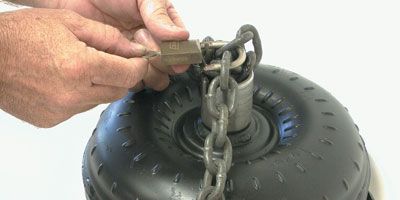
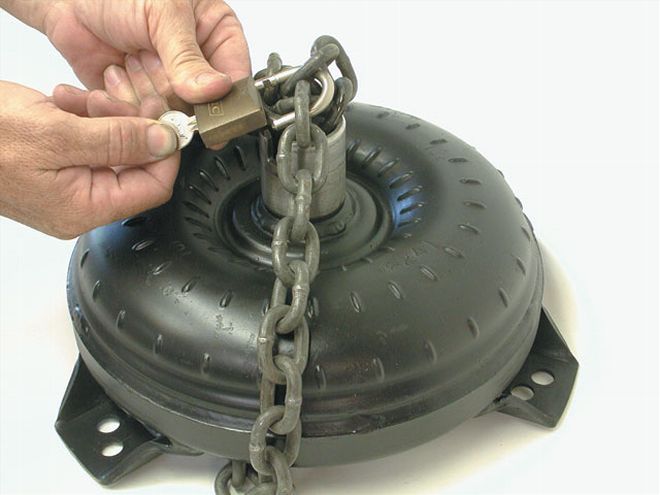
Welcome to the dark world of torque converters. When it comes to automatic-equipped street machines and drag-race cars, the torque converter is a welded-up magic box that few enthusiasts know much about. Sure, there's all kind of talk about stall speed, slippage, and lockup features, but some gearheads secretly believe there's as much voodoo to a torque converter as there is science. To serve up a little enlightenment, let's take a spin through the torque-converter world and make some sense out of all the superstition.
The first automatic transmissions employed what was called a fluid coupling to connect the crankshaft with the transmission. These early units operated on the same principal of using one electric fan to drive another. The drive fan moves air across the blades of the driven fan (which is turned off). This slowly turns the blades of the driven fan in the same direction. This is how the first fluid couplings were designed, but they were hideously inefficient because of high slippage. In this design, the two basic components in the fluid coupling are the impeller blades (the drive side), which are connected to the engine, and the turbine blades (the driven member), which are splined to the input shaft of the transmission.
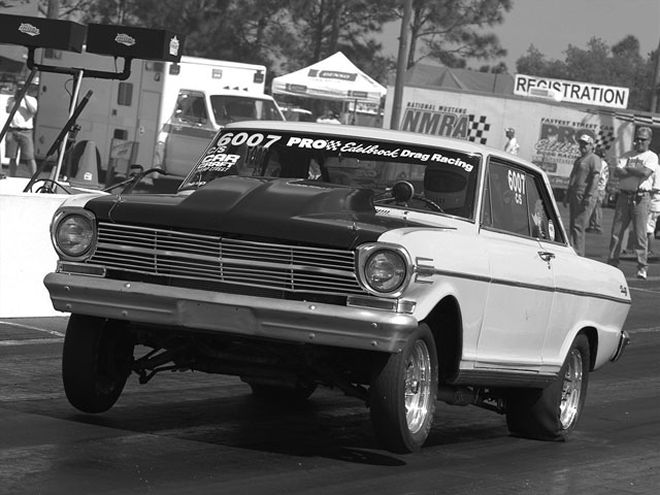 Automatics have become virtually standard in fast street cars on the dragstrip. The only way to put power to the ground with an automatic is with a properly sized converter that best matches your engine's power curve.
Automatics have become virtually standard in fast street cars on the dragstrip. The only way to put power to the ground with an automatic is with a properly sized converter that best matches your engine's power curve.
It took the addition of a small device called the stator to increase the efficiency of the fluid coupling and transform it into a torque converter. The stator redirects fluid from the turbine to the impeller, radically increasing the force of the fluid entering the impeller and multiplying the torque input from the engine. Basically, the fluid exits the center of the turbine and is redirected by the stator back into the impeller. This is a very slick trick and can be worth up to 2.5 times engine torque! This means that at a 2:1 torque multiplication ratio, an engine that is making 300 lb-ft of torque at a stall speed of 2,500 rpm will actually apply 600 lb-ft of torque to the input shaft of the transmission as the car leaves the starting line.
This sounds really great, and it is. But the catch is that this torque multiplication doesn't last very long. The multiplication factor is based on the speed difference between the turbine and impeller. At stall speed, the impeller is spinning at engine rpm and the turbine is stopped. This creates the greatest speed difference between the turbine and the impeller and therefore the maximum torque multiplication. Once the brakes (or the transbrake) is released and the vehicle begins to move, the turbine spins up and the speed difference between the two diminishes. Generally, by the time you reach the 60-foot mark on the dragstrip, torque multiplication is effectively eliminated and the turbine and impeller speeds are close to achieving what converter manufacturers call coupling speed.
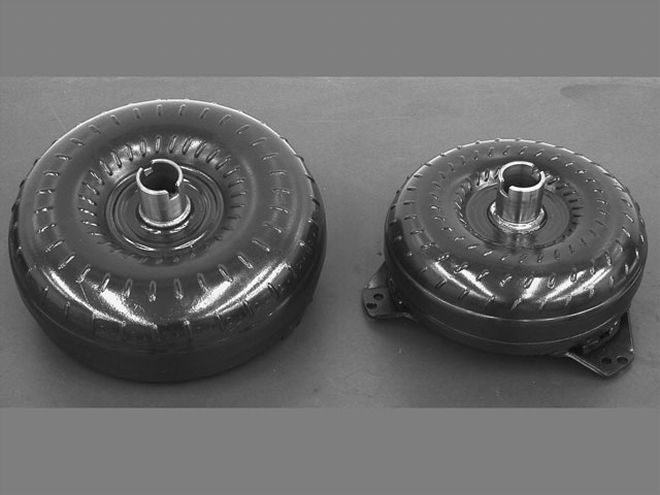 Street/strip torque converters range in diameter from 10 to 13 inches. Larger-diameter converters are the most efficient but heavier. Companies like B&M and others also build "tight" small-diameter converters, especially for nitrous applications.
Street/strip torque converters range in diameter from 10 to 13 inches. Larger-diameter converters are the most efficient but heavier. Companies like B&M and others also build "tight" small-diameter converters, especially for nitrous applications.
Achieving a true 1:1 speed relationship between the turbine and the impeller is not possible with a non-lockup torque converter since it is still a fluid coupling. Most street torque converters tend to operate in the 3 to 5 percent slippage range, but this can go as high as 8 percent. A 5 percent slippage factor means that if the impeller is spinning 3,000 rpm, the turbine is only spinning 2,850, or 5 percent slower. This slippage is part of what determines the stall speed of the converter. By changing the angle of the impeller blades, the torque-converter manufacturer can create a converter that generates a given stall speed with a certain torque multiplication.
A manufacturer's torque-converter rating is generally expressed as an rpm range. It's not more specific because stall speed is highly dependent upon engine torque. Stall speed is measured in the car by applying the brakes and revving the engine in First gear against the brakes. Most street cars cannot keep the rear tires from spinning if you add too much throttle, and this tends to limit the stall speed.
For example, let's say your 355ci small-block makes 230 lb-ft of torque at 2,500 rpm and you bolt in a B&M Holeshot 2000 converter that creates a 2,000-stall speed (this is actually the torque standard that B&M uses to establish stall speed for its street converters). Now let's bolt the same Holeshot 2000 converter behind a larger, 400ci small-block that makes 400 lb-ft of torque at 2,400 rpm. The same converter is now going to exhibit a much higher stall speed, perhaps 2,300 to 2,400 rpm, because the engine is cranking out 170 more lb-ft of torque. So as you can see, stall speed is not an exact science due to multiple factors that affect the converter. Furthermore, if you were to add a transbrake that locks the trans in two gears at once, stall speed will generally increase another 100 to as much as 300 rpm depending upon the application.
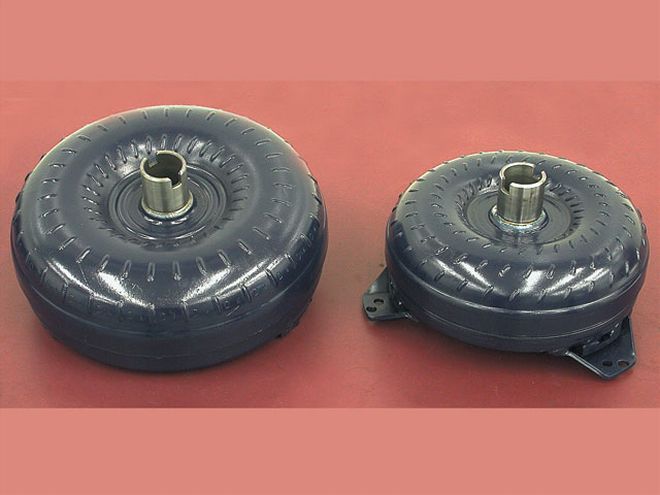 You can tell quite a bit about a converter just by looking at it. Note the angle of the multiple tabs on the larger converter on the left versus the tabs on the smaller converter on the right. Note how the tabs on the small converter are angled in the opposite direction compared to the larger converter. These tabs position the fins in the converter and have been moved to increase the stall speed of this mainly because it was originally used on a low-torque four-cylinder engine.
You can tell quite a bit about a converter just by looking at it. Note the angle of the multiple tabs on the larger converter on the left versus the tabs on the smaller converter on the right. Note how the tabs on the small converter are angled in the opposite direction compared to the larger converter. These tabs position the fins in the converter and have been moved to increase the stall speed of this mainly because it was originally used on a low-torque four-cylinder engine.
The reason for increasing stall speed is directly related to the engine's torque curve. With a manual transmission, you are allowed the freedom to pick the starting-line rpm you want to apply when you dump the clutch. In a car with a good suspension and sticky tires, you can use extra rpm to put the engine closer to its torque peak, launching the car even more quickly. Adding stall speed to the torque converter increases the power available to accelerate the car more quickly.
Unfortunately, additional stall speed also increases the slippage in the converter. For a drag-race car, the cost of this additional slippage is worth the price, but for a street car it creates other problems. A high-stall converter like a 4,000-rpm unit is not only lazy from a part-throttle-efficiency standpoint, but it also generates much more heat. Heat is the enemy of any automatic transmission and will radically reduce its life span if not mediated by an efficient trans cooler.
The issues of slippage and heat are the main reasons that street converters should be approached with a serious amount of compromise when it comes to stall speed. A converter that might have a stall speed of 5,000 rpm for a pure drag car would be completely miserable on the street. Because of the lack of traction and limited tires, it's not critical that a street engine launch at peak-torque rpm. For most hot street engines, converters in the 2,200 to 2,600-rpm range are considered streetable but will still require a very efficient trans cooler to keep them out of the heat zone.
Another important part of the torque converter and stall-speed equation is converter diameter. Larger-diameter converters are usually more efficient and deliver less slippage, while smaller-diameter converters offer more stall speed and more slippage.
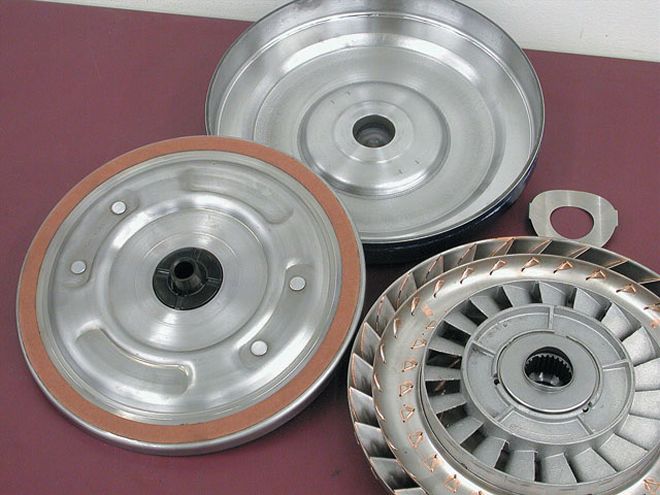
Vehicle weight is another major factor that should be considered when selecting a converter. Big cars weighing over 3,300 pounds generally need a converter with more torque multiplication. A flyweight 2,800-pound car like an early Mustang or Chevy II could use less multiplication to successfully launch on their relatively smaller rear tires.
With the advent of overdrive automatic transmissions like the TH200-4R, the TH700-R4/4L60E, the massive 4L80E, the Ford AOD, and all the rest, the new-car companies were striving for improved fuel economy using overdrive. Overdrive ratios drive the torque converter at speeds generally below normal coupling speed, creating increased slippage and heat, which is unacceptable. This created the demand for a lockup converter employing an internal clutch inside the converter to directly connect the turbine with the input shaft of the transmission just like a manual-transmission clutch.
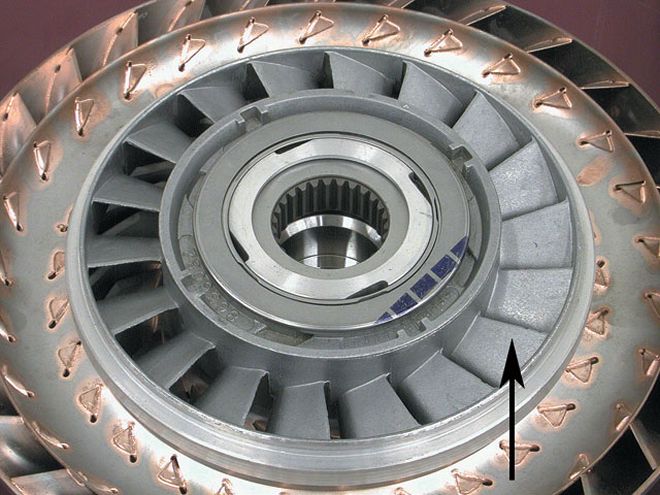 The arrow points to the stator, the small propeller-shaped component that redirects fluid flow into the impeller at maximum stall speed to multiply torque. The stator is fitted with an overrunning clutch that allows it to freewheel once the turbine and impeller approach lockup.
The arrow points to the stator, the small propeller-shaped component that redirects fluid flow into the impeller at maximum stall speed to multiply torque. The stator is fitted with an overrunning clutch that allows it to freewheel once the turbine and impeller approach lockup.
Many aftermarket companies offer performance lockup torque converters that can provide a higher stall speed without sacrificing the advantages of the lockup converter for highway use. The downside to these converters is that they are heavier and more expensive than non-lockup converters.
It's also important not to undersell converter weight as a contributing factor to maximizing acceleration. The combination of a smaller-diameter and lighter converter means that less engine torque is required for acceleration. This is not a huge factor in the overall lower-e.t. scheme, but it does contribute.
This has been a quick jaunt through world of torque converters, but it should at least inspire some intelligent questions to ask your converter company of choice as to the best converter for your application. It's all about creating an overall tuned package that complements the rest of your car. That should make you and your car happy.